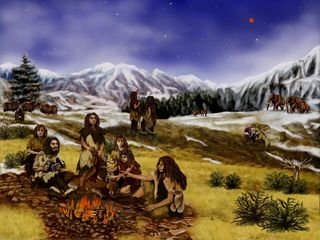Neanderthals' Legs Look Ideal for Steep-Hillside Strolls

Neanderthals had shorter lower legs than we do, leading scientists to theorize that this was an adaptation to the cold times in which they lived, even if it slowed them down.
But two scientists offer a new explanation for those short lower legs: They allowed these early humans to move efficiently across the sloped terrain of their mountainous homes. Instead of being at a disadvantage on rugged terrain, as was generally thought, Neanderthals even may have been at an advantage, depending on the nature of the slope, they found. The research team also found the same connection between shorter lower-leg bones and mountain life among modern animals. [The Many Mysteries of Neanderthals]
"Studies looking at limb length have always concluded that a shorter limb, including in Neanderthals, leads to less efficiency of movement, because they had to take more steps to go a given distance. But the other studies only looked at flat land," said lead researcher Ryan Higgins, a graduate student in the Johns Hopkins Center of Functional Anatomy and Evolution. "Our study suggests that the Neanderthals' steps were not less efficient than modern humans in the sloped, mountainous environment where they lived."
Neanderthals lived between about 200,000 and 40,000 years ago, during the cold of ice-age Europe and Western Asia. They had a shorter, more compact stature than we do. Since animals in colder areas tend to be more compact — less surface area means less body heat loss — this appeared to explain the length of a Neanderthal's lower legs. More-modern humans, by contrast, lived in warmer climates, meaning they were less concerned about losing body heat.
Neanderthals also lived in more-mountainous places. Using a mathematical model relating leg proportions to the angle of ascent, the researchers found that Neanderthals' proportions would have helped them move about on slopes.
"It has to do with leg clearance as you are going up a slope," explained researcher Christopher Ruff, also of Johns Hopkins. He said that if the lower half of your leg – the part below the knee – is shorter, you can take bigger steps, relative to your height, while traveling uphill. This is because you don't have to bend your knee or hip as much to clear the ground.
Higgins and Ruff also analyzed the relationship between lower leg-bone length and habitat for a group of mammals called bovids, which includes flat- and hilly-dwelling species of gazelles, antelopes, goats and sheep. They found that, overall, the mountainous species had shorter lower leg bones than those on flat land, even when they lived in the same climate.
Sign up for the Live Science daily newsletter now
Get the world’s most fascinating discoveries delivered straight to your inbox.
The research was published online in the American Journal of Physical Anthropology.
You can follow LiveScience senior writer Wynne Parry on Twitter @Wynne_Parry. Follow LiveScience for the latest in science news and discoveries on Twitter @livescience and on Facebook.

